3D Printing Technology: A Milestone in Technology History Essay
VerifiedAdded on 2021/04/17
|7
|2114
|52
Essay
AI Summary
This essay analyzes 3D printing technology as a significant milestone in technological history, also known as additive manufacturing. It traces the technology's origins back to the 1980s with Charles Hull's invention of the first 3D printer, highlighting key developments such as rapid prototyping and the evolution of CAD software. The essay explores the motivations behind 3D printing, emphasizing its potential to create complex objects with high accuracy, which has led to applications in various sectors, including manufacturing and healthcare. It discusses the technology's impact on society, including its affordability, applications in prosthetics and space exploration, and environmental benefits. The essay concludes by predicting future trends, such as increased affordability, material innovation, and its influence on manufacturing and education, reinforcing its potential to revolutionize various industries and improve lives.
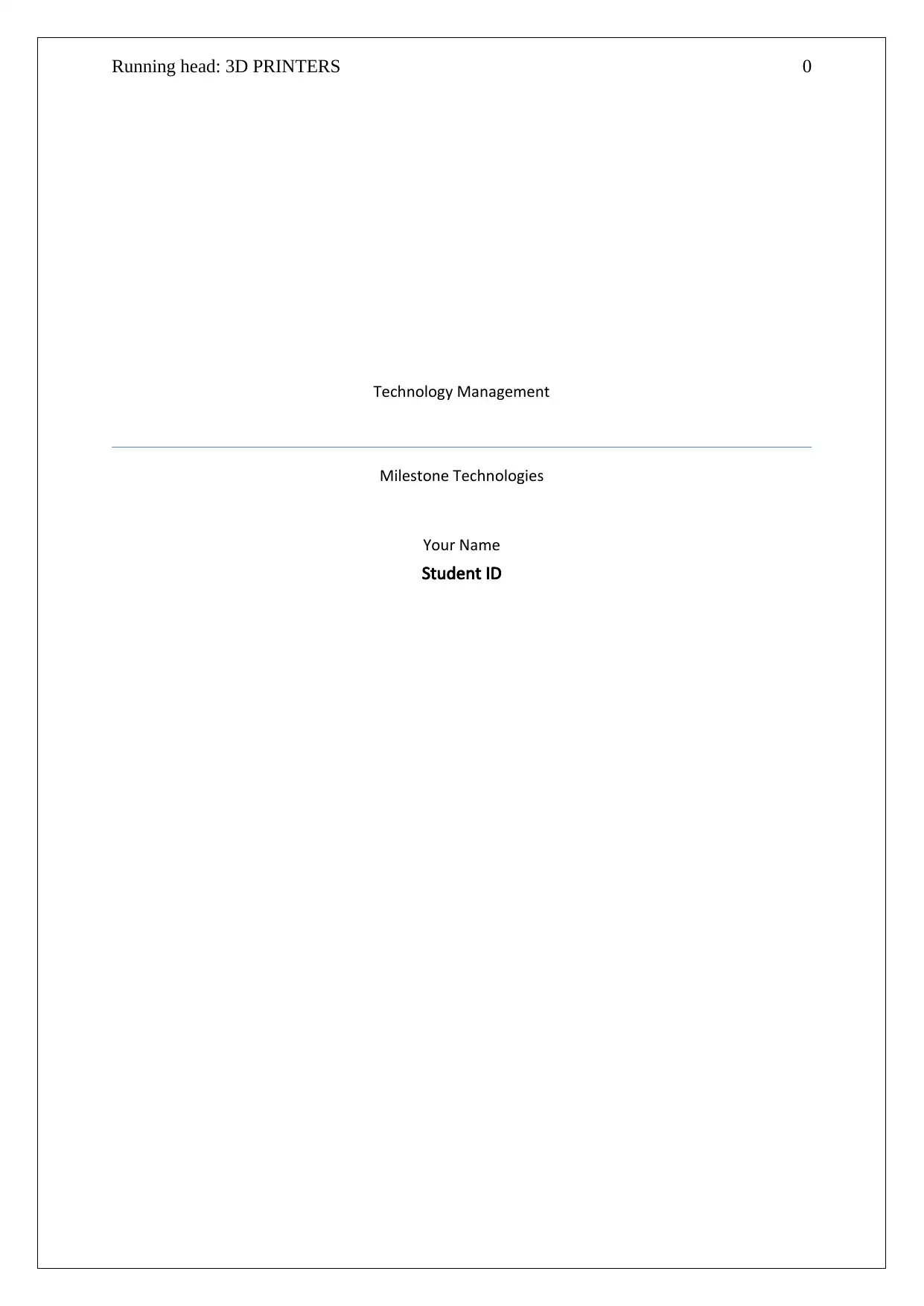
Running head: 3D PRINTERS 0
Technology Management
Milestone Technologies
Your Name
Student ID
Technology Management
Milestone Technologies
Your Name
Student ID
Paraphrase This Document
Need a fresh take? Get an instant paraphrase of this document with our AI Paraphraser
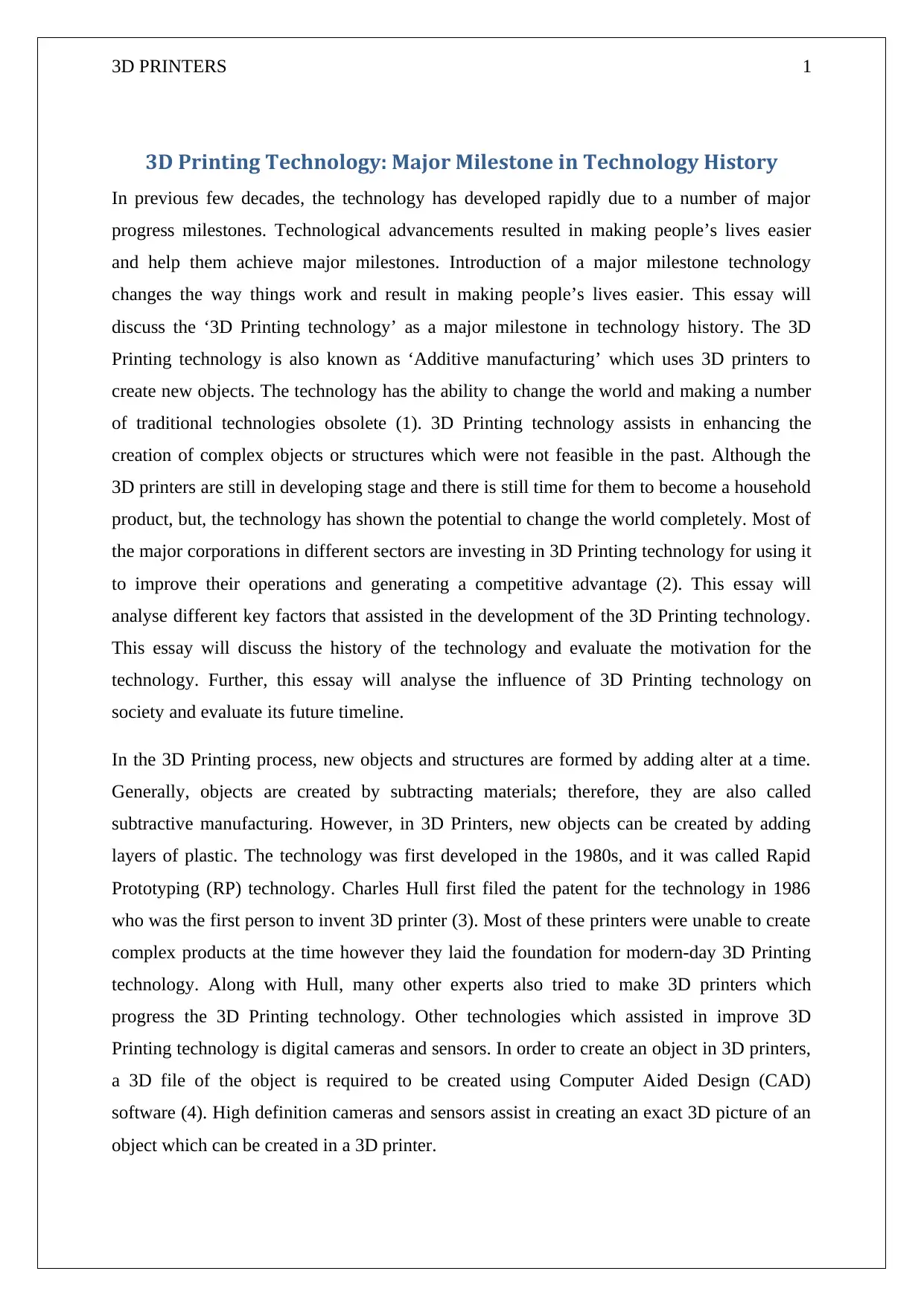
3D PRINTERS 1
3D Printing Technology: Major Milestone in Technology History
In previous few decades, the technology has developed rapidly due to a number of major
progress milestones. Technological advancements resulted in making people’s lives easier
and help them achieve major milestones. Introduction of a major milestone technology
changes the way things work and result in making people’s lives easier. This essay will
discuss the ‘3D Printing technology’ as a major milestone in technology history. The 3D
Printing technology is also known as ‘Additive manufacturing’ which uses 3D printers to
create new objects. The technology has the ability to change the world and making a number
of traditional technologies obsolete (1). 3D Printing technology assists in enhancing the
creation of complex objects or structures which were not feasible in the past. Although the
3D printers are still in developing stage and there is still time for them to become a household
product, but, the technology has shown the potential to change the world completely. Most of
the major corporations in different sectors are investing in 3D Printing technology for using it
to improve their operations and generating a competitive advantage (2). This essay will
analyse different key factors that assisted in the development of the 3D Printing technology.
This essay will discuss the history of the technology and evaluate the motivation for the
technology. Further, this essay will analyse the influence of 3D Printing technology on
society and evaluate its future timeline.
In the 3D Printing process, new objects and structures are formed by adding alter at a time.
Generally, objects are created by subtracting materials; therefore, they are also called
subtractive manufacturing. However, in 3D Printers, new objects can be created by adding
layers of plastic. The technology was first developed in the 1980s, and it was called Rapid
Prototyping (RP) technology. Charles Hull first filed the patent for the technology in 1986
who was the first person to invent 3D printer (3). Most of these printers were unable to create
complex products at the time however they laid the foundation for modern-day 3D Printing
technology. Along with Hull, many other experts also tried to make 3D printers which
progress the 3D Printing technology. Other technologies which assisted in improve 3D
Printing technology is digital cameras and sensors. In order to create an object in 3D printers,
a 3D file of the object is required to be created using Computer Aided Design (CAD)
software (4). High definition cameras and sensors assist in creating an exact 3D picture of an
object which can be created in a 3D printer.
3D Printing Technology: Major Milestone in Technology History
In previous few decades, the technology has developed rapidly due to a number of major
progress milestones. Technological advancements resulted in making people’s lives easier
and help them achieve major milestones. Introduction of a major milestone technology
changes the way things work and result in making people’s lives easier. This essay will
discuss the ‘3D Printing technology’ as a major milestone in technology history. The 3D
Printing technology is also known as ‘Additive manufacturing’ which uses 3D printers to
create new objects. The technology has the ability to change the world and making a number
of traditional technologies obsolete (1). 3D Printing technology assists in enhancing the
creation of complex objects or structures which were not feasible in the past. Although the
3D printers are still in developing stage and there is still time for them to become a household
product, but, the technology has shown the potential to change the world completely. Most of
the major corporations in different sectors are investing in 3D Printing technology for using it
to improve their operations and generating a competitive advantage (2). This essay will
analyse different key factors that assisted in the development of the 3D Printing technology.
This essay will discuss the history of the technology and evaluate the motivation for the
technology. Further, this essay will analyse the influence of 3D Printing technology on
society and evaluate its future timeline.
In the 3D Printing process, new objects and structures are formed by adding alter at a time.
Generally, objects are created by subtracting materials; therefore, they are also called
subtractive manufacturing. However, in 3D Printers, new objects can be created by adding
layers of plastic. The technology was first developed in the 1980s, and it was called Rapid
Prototyping (RP) technology. Charles Hull first filed the patent for the technology in 1986
who was the first person to invent 3D printer (3). Most of these printers were unable to create
complex products at the time however they laid the foundation for modern-day 3D Printing
technology. Along with Hull, many other experts also tried to make 3D printers which
progress the 3D Printing technology. Other technologies which assisted in improve 3D
Printing technology is digital cameras and sensors. In order to create an object in 3D printers,
a 3D file of the object is required to be created using Computer Aided Design (CAD)
software (4). High definition cameras and sensors assist in creating an exact 3D picture of an
object which can be created in a 3D printer.
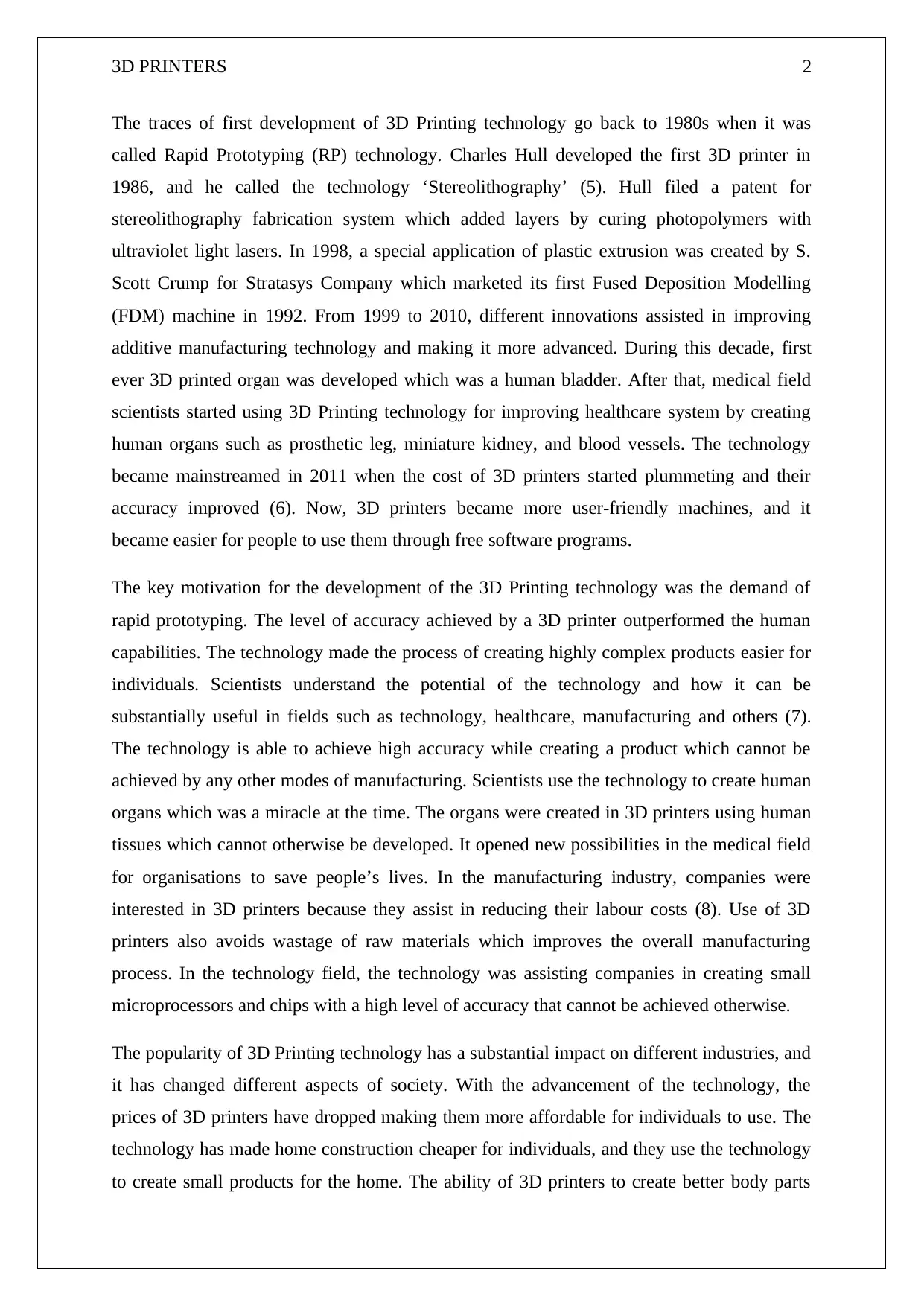
3D PRINTERS 2
The traces of first development of 3D Printing technology go back to 1980s when it was
called Rapid Prototyping (RP) technology. Charles Hull developed the first 3D printer in
1986, and he called the technology ‘Stereolithography’ (5). Hull filed a patent for
stereolithography fabrication system which added layers by curing photopolymers with
ultraviolet light lasers. In 1998, a special application of plastic extrusion was created by S.
Scott Crump for Stratasys Company which marketed its first Fused Deposition Modelling
(FDM) machine in 1992. From 1999 to 2010, different innovations assisted in improving
additive manufacturing technology and making it more advanced. During this decade, first
ever 3D printed organ was developed which was a human bladder. After that, medical field
scientists started using 3D Printing technology for improving healthcare system by creating
human organs such as prosthetic leg, miniature kidney, and blood vessels. The technology
became mainstreamed in 2011 when the cost of 3D printers started plummeting and their
accuracy improved (6). Now, 3D printers became more user-friendly machines, and it
became easier for people to use them through free software programs.
The key motivation for the development of the 3D Printing technology was the demand of
rapid prototyping. The level of accuracy achieved by a 3D printer outperformed the human
capabilities. The technology made the process of creating highly complex products easier for
individuals. Scientists understand the potential of the technology and how it can be
substantially useful in fields such as technology, healthcare, manufacturing and others (7).
The technology is able to achieve high accuracy while creating a product which cannot be
achieved by any other modes of manufacturing. Scientists use the technology to create human
organs which was a miracle at the time. The organs were created in 3D printers using human
tissues which cannot otherwise be developed. It opened new possibilities in the medical field
for organisations to save people’s lives. In the manufacturing industry, companies were
interested in 3D printers because they assist in reducing their labour costs (8). Use of 3D
printers also avoids wastage of raw materials which improves the overall manufacturing
process. In the technology field, the technology was assisting companies in creating small
microprocessors and chips with a high level of accuracy that cannot be achieved otherwise.
The popularity of 3D Printing technology has a substantial impact on different industries, and
it has changed different aspects of society. With the advancement of the technology, the
prices of 3D printers have dropped making them more affordable for individuals to use. The
technology has made home construction cheaper for individuals, and they use the technology
to create small products for the home. The ability of 3D printers to create better body parts
The traces of first development of 3D Printing technology go back to 1980s when it was
called Rapid Prototyping (RP) technology. Charles Hull developed the first 3D printer in
1986, and he called the technology ‘Stereolithography’ (5). Hull filed a patent for
stereolithography fabrication system which added layers by curing photopolymers with
ultraviolet light lasers. In 1998, a special application of plastic extrusion was created by S.
Scott Crump for Stratasys Company which marketed its first Fused Deposition Modelling
(FDM) machine in 1992. From 1999 to 2010, different innovations assisted in improving
additive manufacturing technology and making it more advanced. During this decade, first
ever 3D printed organ was developed which was a human bladder. After that, medical field
scientists started using 3D Printing technology for improving healthcare system by creating
human organs such as prosthetic leg, miniature kidney, and blood vessels. The technology
became mainstreamed in 2011 when the cost of 3D printers started plummeting and their
accuracy improved (6). Now, 3D printers became more user-friendly machines, and it
became easier for people to use them through free software programs.
The key motivation for the development of the 3D Printing technology was the demand of
rapid prototyping. The level of accuracy achieved by a 3D printer outperformed the human
capabilities. The technology made the process of creating highly complex products easier for
individuals. Scientists understand the potential of the technology and how it can be
substantially useful in fields such as technology, healthcare, manufacturing and others (7).
The technology is able to achieve high accuracy while creating a product which cannot be
achieved by any other modes of manufacturing. Scientists use the technology to create human
organs which was a miracle at the time. The organs were created in 3D printers using human
tissues which cannot otherwise be developed. It opened new possibilities in the medical field
for organisations to save people’s lives. In the manufacturing industry, companies were
interested in 3D printers because they assist in reducing their labour costs (8). Use of 3D
printers also avoids wastage of raw materials which improves the overall manufacturing
process. In the technology field, the technology was assisting companies in creating small
microprocessors and chips with a high level of accuracy that cannot be achieved otherwise.
The popularity of 3D Printing technology has a substantial impact on different industries, and
it has changed different aspects of society. With the advancement of the technology, the
prices of 3D printers have dropped making them more affordable for individuals to use. The
technology has made home construction cheaper for individuals, and they use the technology
to create small products for the home. The ability of 3D printers to create better body parts
⊘ This is a preview!⊘
Do you want full access?
Subscribe today to unlock all pages.

Trusted by 1+ million students worldwide
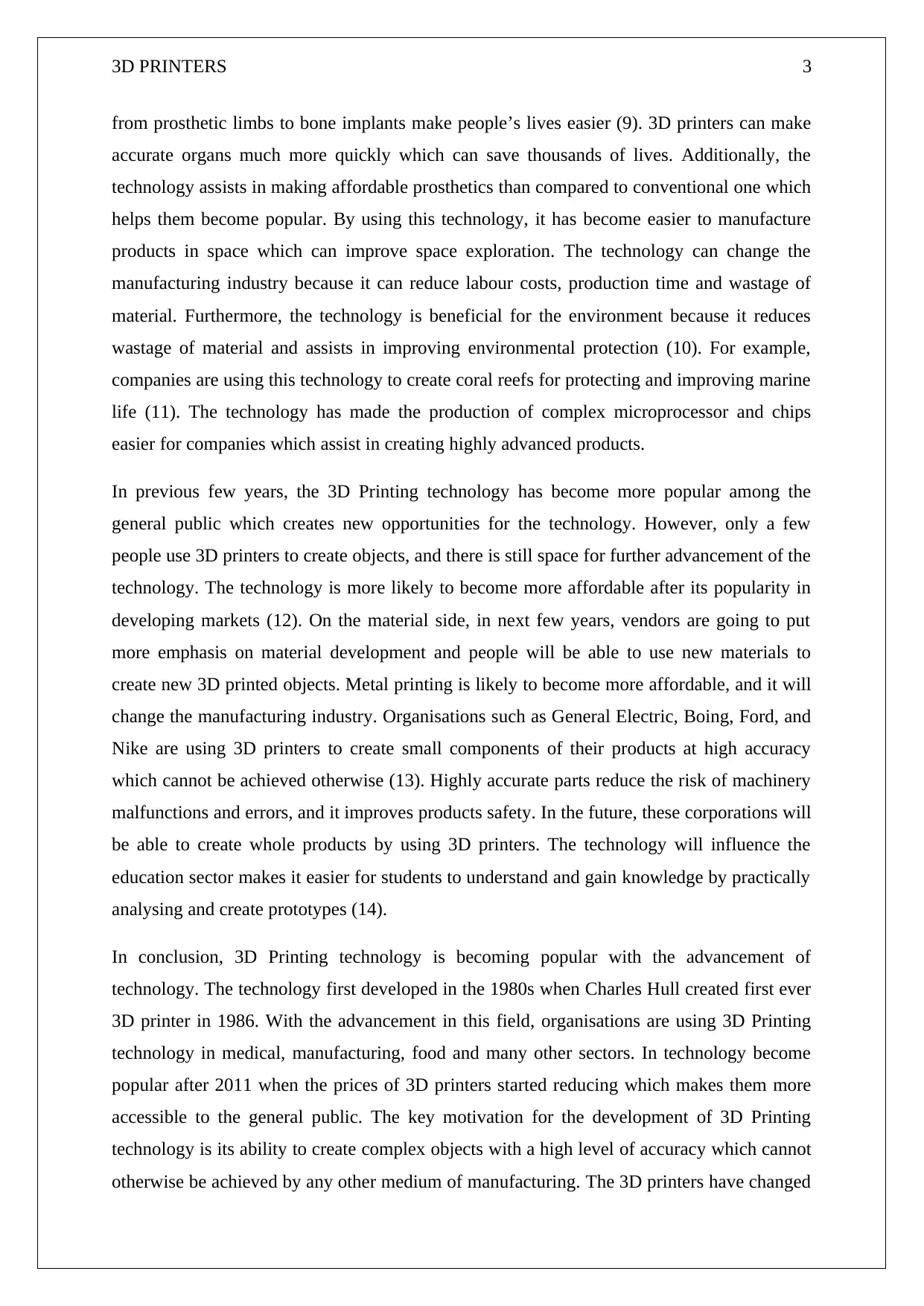
3D PRINTERS 3
from prosthetic limbs to bone implants make people’s lives easier (9). 3D printers can make
accurate organs much more quickly which can save thousands of lives. Additionally, the
technology assists in making affordable prosthetics than compared to conventional one which
helps them become popular. By using this technology, it has become easier to manufacture
products in space which can improve space exploration. The technology can change the
manufacturing industry because it can reduce labour costs, production time and wastage of
material. Furthermore, the technology is beneficial for the environment because it reduces
wastage of material and assists in improving environmental protection (10). For example,
companies are using this technology to create coral reefs for protecting and improving marine
life (11). The technology has made the production of complex microprocessor and chips
easier for companies which assist in creating highly advanced products.
In previous few years, the 3D Printing technology has become more popular among the
general public which creates new opportunities for the technology. However, only a few
people use 3D printers to create objects, and there is still space for further advancement of the
technology. The technology is more likely to become more affordable after its popularity in
developing markets (12). On the material side, in next few years, vendors are going to put
more emphasis on material development and people will be able to use new materials to
create new 3D printed objects. Metal printing is likely to become more affordable, and it will
change the manufacturing industry. Organisations such as General Electric, Boing, Ford, and
Nike are using 3D printers to create small components of their products at high accuracy
which cannot be achieved otherwise (13). Highly accurate parts reduce the risk of machinery
malfunctions and errors, and it improves products safety. In the future, these corporations will
be able to create whole products by using 3D printers. The technology will influence the
education sector makes it easier for students to understand and gain knowledge by practically
analysing and create prototypes (14).
In conclusion, 3D Printing technology is becoming popular with the advancement of
technology. The technology first developed in the 1980s when Charles Hull created first ever
3D printer in 1986. With the advancement in this field, organisations are using 3D Printing
technology in medical, manufacturing, food and many other sectors. In technology become
popular after 2011 when the prices of 3D printers started reducing which makes them more
accessible to the general public. The key motivation for the development of 3D Printing
technology is its ability to create complex objects with a high level of accuracy which cannot
otherwise be achieved by any other medium of manufacturing. The 3D printers have changed
from prosthetic limbs to bone implants make people’s lives easier (9). 3D printers can make
accurate organs much more quickly which can save thousands of lives. Additionally, the
technology assists in making affordable prosthetics than compared to conventional one which
helps them become popular. By using this technology, it has become easier to manufacture
products in space which can improve space exploration. The technology can change the
manufacturing industry because it can reduce labour costs, production time and wastage of
material. Furthermore, the technology is beneficial for the environment because it reduces
wastage of material and assists in improving environmental protection (10). For example,
companies are using this technology to create coral reefs for protecting and improving marine
life (11). The technology has made the production of complex microprocessor and chips
easier for companies which assist in creating highly advanced products.
In previous few years, the 3D Printing technology has become more popular among the
general public which creates new opportunities for the technology. However, only a few
people use 3D printers to create objects, and there is still space for further advancement of the
technology. The technology is more likely to become more affordable after its popularity in
developing markets (12). On the material side, in next few years, vendors are going to put
more emphasis on material development and people will be able to use new materials to
create new 3D printed objects. Metal printing is likely to become more affordable, and it will
change the manufacturing industry. Organisations such as General Electric, Boing, Ford, and
Nike are using 3D printers to create small components of their products at high accuracy
which cannot be achieved otherwise (13). Highly accurate parts reduce the risk of machinery
malfunctions and errors, and it improves products safety. In the future, these corporations will
be able to create whole products by using 3D printers. The technology will influence the
education sector makes it easier for students to understand and gain knowledge by practically
analysing and create prototypes (14).
In conclusion, 3D Printing technology is becoming popular with the advancement of
technology. The technology first developed in the 1980s when Charles Hull created first ever
3D printer in 1986. With the advancement in this field, organisations are using 3D Printing
technology in medical, manufacturing, food and many other sectors. In technology become
popular after 2011 when the prices of 3D printers started reducing which makes them more
accessible to the general public. The key motivation for the development of 3D Printing
technology is its ability to create complex objects with a high level of accuracy which cannot
otherwise be achieved by any other medium of manufacturing. The 3D printers have changed
Paraphrase This Document
Need a fresh take? Get an instant paraphrase of this document with our AI Paraphraser

3D PRINTERS 4
society by making prosthetics affordable, creating human organs, complex microprocessors,
and reducing material wastage. In the future, the 3D printing will become more accessible to
the general public, and they will be able to use different materials for creating new objects
and structures. It will influence manufacturing industry by reducing wastage of material and
overall operating costs. The technology has the potential to change different industries and
improve the lives of people.
society by making prosthetics affordable, creating human organs, complex microprocessors,
and reducing material wastage. In the future, the 3D printing will become more accessible to
the general public, and they will be able to use different materials for creating new objects
and structures. It will influence manufacturing industry by reducing wastage of material and
overall operating costs. The technology has the potential to change different industries and
improve the lives of people.
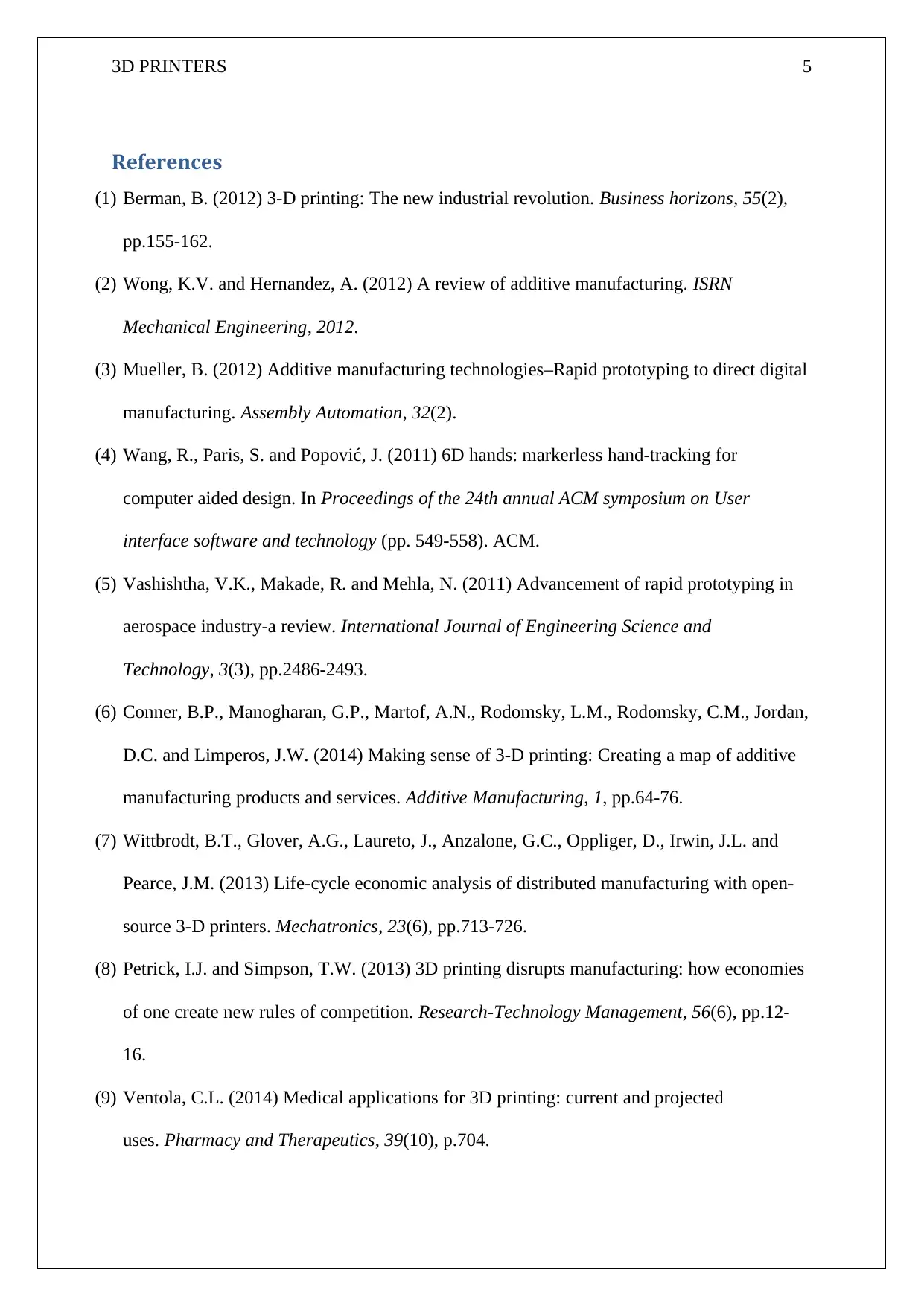
3D PRINTERS 5
References
(1) Berman, B. (2012) 3-D printing: The new industrial revolution. Business horizons, 55(2),
pp.155-162.
(2) Wong, K.V. and Hernandez, A. (2012) A review of additive manufacturing. ISRN
Mechanical Engineering, 2012.
(3) Mueller, B. (2012) Additive manufacturing technologies–Rapid prototyping to direct digital
manufacturing. Assembly Automation, 32(2).
(4) Wang, R., Paris, S. and Popović, J. (2011) 6D hands: markerless hand-tracking for
computer aided design. In Proceedings of the 24th annual ACM symposium on User
interface software and technology (pp. 549-558). ACM.
(5) Vashishtha, V.K., Makade, R. and Mehla, N. (2011) Advancement of rapid prototyping in
aerospace industry-a review. International Journal of Engineering Science and
Technology, 3(3), pp.2486-2493.
(6) Conner, B.P., Manogharan, G.P., Martof, A.N., Rodomsky, L.M., Rodomsky, C.M., Jordan,
D.C. and Limperos, J.W. (2014) Making sense of 3-D printing: Creating a map of additive
manufacturing products and services. Additive Manufacturing, 1, pp.64-76.
(7) Wittbrodt, B.T., Glover, A.G., Laureto, J., Anzalone, G.C., Oppliger, D., Irwin, J.L. and
Pearce, J.M. (2013) Life-cycle economic analysis of distributed manufacturing with open-
source 3-D printers. Mechatronics, 23(6), pp.713-726.
(8) Petrick, I.J. and Simpson, T.W. (2013) 3D printing disrupts manufacturing: how economies
of one create new rules of competition. Research-Technology Management, 56(6), pp.12-
16.
(9) Ventola, C.L. (2014) Medical applications for 3D printing: current and projected
uses. Pharmacy and Therapeutics, 39(10), p.704.
References
(1) Berman, B. (2012) 3-D printing: The new industrial revolution. Business horizons, 55(2),
pp.155-162.
(2) Wong, K.V. and Hernandez, A. (2012) A review of additive manufacturing. ISRN
Mechanical Engineering, 2012.
(3) Mueller, B. (2012) Additive manufacturing technologies–Rapid prototyping to direct digital
manufacturing. Assembly Automation, 32(2).
(4) Wang, R., Paris, S. and Popović, J. (2011) 6D hands: markerless hand-tracking for
computer aided design. In Proceedings of the 24th annual ACM symposium on User
interface software and technology (pp. 549-558). ACM.
(5) Vashishtha, V.K., Makade, R. and Mehla, N. (2011) Advancement of rapid prototyping in
aerospace industry-a review. International Journal of Engineering Science and
Technology, 3(3), pp.2486-2493.
(6) Conner, B.P., Manogharan, G.P., Martof, A.N., Rodomsky, L.M., Rodomsky, C.M., Jordan,
D.C. and Limperos, J.W. (2014) Making sense of 3-D printing: Creating a map of additive
manufacturing products and services. Additive Manufacturing, 1, pp.64-76.
(7) Wittbrodt, B.T., Glover, A.G., Laureto, J., Anzalone, G.C., Oppliger, D., Irwin, J.L. and
Pearce, J.M. (2013) Life-cycle economic analysis of distributed manufacturing with open-
source 3-D printers. Mechatronics, 23(6), pp.713-726.
(8) Petrick, I.J. and Simpson, T.W. (2013) 3D printing disrupts manufacturing: how economies
of one create new rules of competition. Research-Technology Management, 56(6), pp.12-
16.
(9) Ventola, C.L. (2014) Medical applications for 3D printing: current and projected
uses. Pharmacy and Therapeutics, 39(10), p.704.
⊘ This is a preview!⊘
Do you want full access?
Subscribe today to unlock all pages.

Trusted by 1+ million students worldwide
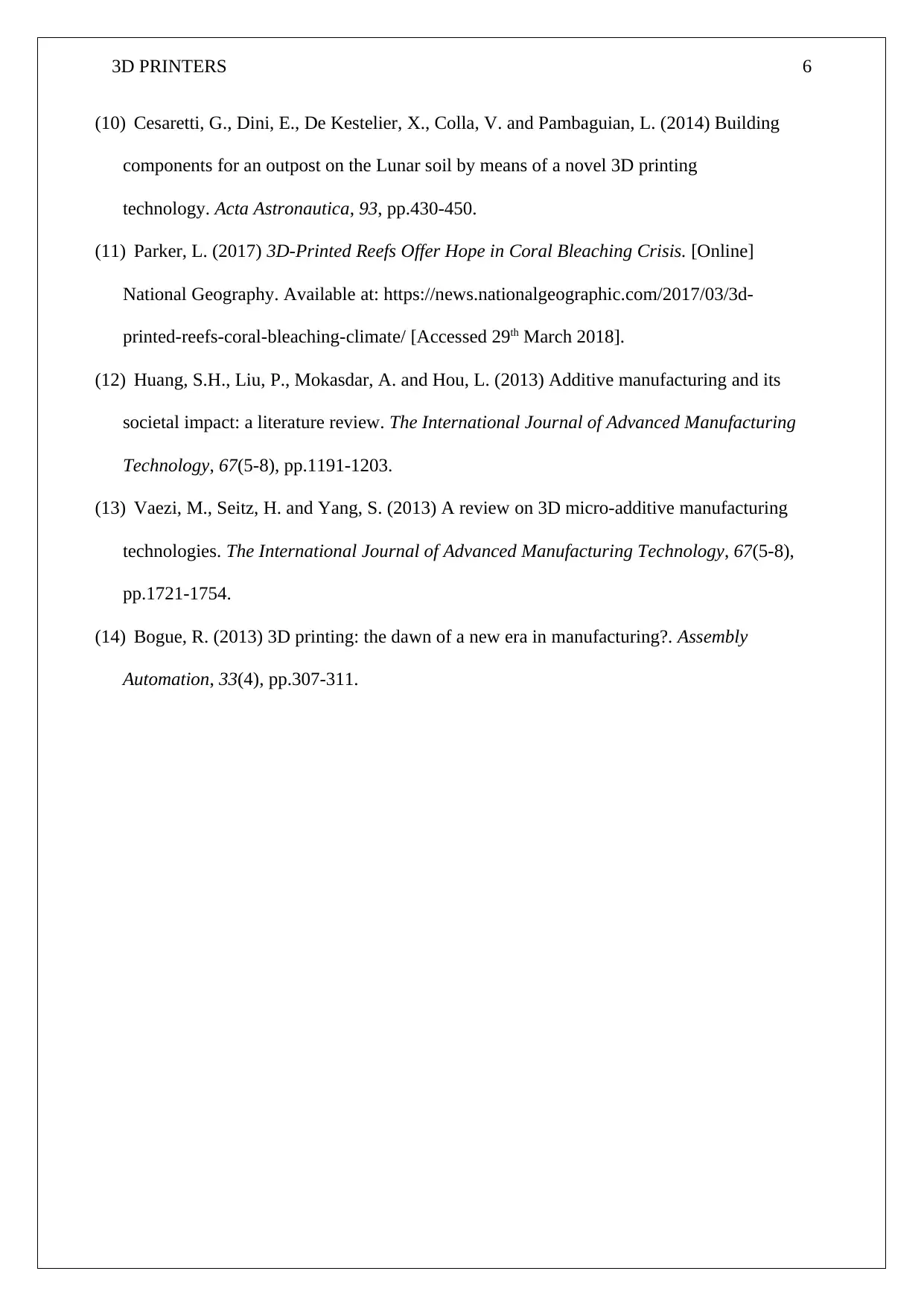
3D PRINTERS 6
(10) Cesaretti, G., Dini, E., De Kestelier, X., Colla, V. and Pambaguian, L. (2014) Building
components for an outpost on the Lunar soil by means of a novel 3D printing
technology. Acta Astronautica, 93, pp.430-450.
(11) Parker, L. (2017) 3D-Printed Reefs Offer Hope in Coral Bleaching Crisis. [Online]
National Geography. Available at: https://news.nationalgeographic.com/2017/03/3d-
printed-reefs-coral-bleaching-climate/ [Accessed 29th March 2018].
(12) Huang, S.H., Liu, P., Mokasdar, A. and Hou, L. (2013) Additive manufacturing and its
societal impact: a literature review. The International Journal of Advanced Manufacturing
Technology, 67(5-8), pp.1191-1203.
(13) Vaezi, M., Seitz, H. and Yang, S. (2013) A review on 3D micro-additive manufacturing
technologies. The International Journal of Advanced Manufacturing Technology, 67(5-8),
pp.1721-1754.
(14) Bogue, R. (2013) 3D printing: the dawn of a new era in manufacturing?. Assembly
Automation, 33(4), pp.307-311.
(10) Cesaretti, G., Dini, E., De Kestelier, X., Colla, V. and Pambaguian, L. (2014) Building
components for an outpost on the Lunar soil by means of a novel 3D printing
technology. Acta Astronautica, 93, pp.430-450.
(11) Parker, L. (2017) 3D-Printed Reefs Offer Hope in Coral Bleaching Crisis. [Online]
National Geography. Available at: https://news.nationalgeographic.com/2017/03/3d-
printed-reefs-coral-bleaching-climate/ [Accessed 29th March 2018].
(12) Huang, S.H., Liu, P., Mokasdar, A. and Hou, L. (2013) Additive manufacturing and its
societal impact: a literature review. The International Journal of Advanced Manufacturing
Technology, 67(5-8), pp.1191-1203.
(13) Vaezi, M., Seitz, H. and Yang, S. (2013) A review on 3D micro-additive manufacturing
technologies. The International Journal of Advanced Manufacturing Technology, 67(5-8),
pp.1721-1754.
(14) Bogue, R. (2013) 3D printing: the dawn of a new era in manufacturing?. Assembly
Automation, 33(4), pp.307-311.
1 out of 7
Related Documents
Your All-in-One AI-Powered Toolkit for Academic Success.
+13062052269
info@desklib.com
Available 24*7 on WhatsApp / Email
![[object Object]](/_next/static/media/star-bottom.7253800d.svg)
Unlock your academic potential
Copyright © 2020–2025 A2Z Services. All Rights Reserved. Developed and managed by ZUCOL.





